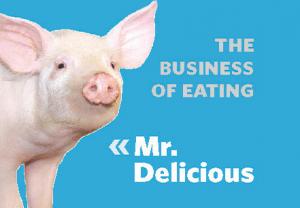Hi! I’m your guest columnist this week. My owners call me Mr. Delicious. My family name is in Latin and hard to pronounce, so pretty much everybody just refers to me as a big pig. And that’s music to my little pointy ears. I live on a sustainable farm – perhaps in Missouri, Georgia or even Kansas. Now, before you start going all “Babe” on me (it’s just a movie, for goodness sakes!), I’ll tell you right off that I know why I’m here and I’m fine with it. Generation after generation of my relatives have been carefully bred to make your dinner as tasty and nourishing as possible. But a lot can happen between the farm and a restaurant’s kitchen.
Speaking of relatives, the latest talk around the pen is all the buzz over “farm to table.” We notice more than you think we do, and it seems that some humans play fast and loose with the idea. If some chef buys a sack of rutabagas from a guy by the side of the road, is his cuisine now “farm to table?” After all, most fruits, vegetables and proteins start out on a farm – somewhere. I’ve got the family photos to prove it.
Speaking of family, the owners of sustainable farms that produce Heritage pork breeds such as Duroc and Red Wattle take the idea of breed sustainability very seriously. In fact, that’s why I’m here. They’ve invested big bucks in farmland and livestock (that’s me!) so they can bring quality stuff from their farm to your table.
They think I’m not listening, but I overhear them talking, and the sad fact is that not all of my brothers and sisters are treated as well as I am. When a restaurant buys pork from a typical food purveyor, there’s a chance that we’re already butchered and packaged. (Remember, I’m OK with this, so relax.) The chef has little control over how we were raised, and by the time we’re trimmed, packaged, stored and transported in big trucks from who-knows-where, we can end up being pretty expensive – especially nowadays. I may be just a humble porker, but even I know that those costs have to factor into the price of what goes onto your plate at your favorite restaurant.
Furthermore, my family and friends who are raised in gigantic commercial facilities are sometimes fed antibiotics and feeds that are hard for them to digest. Yuck! I’ve even heard rumors of crowded pens and not-very-humane treatment. Not a good thing! The bottom line is that diners can end up with mediocre but very expensive meat on their plates. That doesn’t make me happy; I’d prefer to be the best that I can be.
I mentioned Heritage. Heritage refers to breeds that were common before agriculture became really big business. Hog breeds like Red Wattle, American Guinea and Wessex Saddlebacks survive to this day, generally on smaller, sustainable farms. They’re known for excellent marbling (read: flavor!) and, interestingly enough, an easygoing demeanor. Not all of us were developed here in the United States. Berkshire and Gloucestershire Old Spots came here from England. However, Hereford and Red Wattle breeds were developed right here in the good ol’ USA.
The sad fact is that some of these delicious breeds are fading out. They are very expensive to raise, requiring more pasture (read: money) on which to graze, not to mention specific feeds, etc. The only way these Heritage varieties can survive is for farmers and restaurants to educate customers on how much better we taste when we’re sustainable and treated humanely. And it’s already happening: That’s why you’ll see words like Berkshire, Duroc and Heritage describing the menu entrées at some better restaurants.
At these sustainably oriented farms and ranches, I get to scamper around in big roomy spaces (well, as much as something that weighs 200 pounds can scamper), and when the time does come, I’m treated humanely and prepared under tight controls.
The good news is that sustainability and humane treatment help define a clear trail from the farm to the kitchen – and to your table. And I’m happy to be a part of it. Do me one favor, though: The next time you dine in a good restaurant, don’t overlook the beef, lamb, duck, turkey and chicken dishes. I sure don’t mind being the other white meat, but a few more days in this cushy pen would be nice.
Bob Yesbek writes and talks beach eats nonstop. He can be reached at byesbek@capegazette.com.





















































